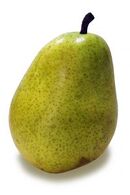Pear
“What a delight, even though I was craving an apple.”
Pears are not apples. Although they grow on trees (like apples), have a core with seeds surrounded by lots of fruity goodness (like apples) and come in the same colours and textures as apples (like apples), they are in fact not at all apples. Pears probably derive their name from the feature that most distinguishes them from apples: their 'pear'-shapedness.
Cultivation[edit]
Pears are native to the tempearate regions of Peru (pronounce: pear-ooh), in South-America. They grow on pear trees. Pear trees can reach heights up to 9 m (30 ft), when standing on the tips of their roots. Pear trees are not seldom confused with apple trees by the casual observer, for when viewed from underneath a pear looks disturbingly like an apple. It is however not an apple. This cannot be stressed enough.
Pears are very self-conscious and need lots of light and encouragement to grow. When malnourished or cultivated in shaded areas, pears will often grow moody and depressed, pondering how much better life would have been if they had been apples. This characteristic gloominess has even led to the proverbial 'going pear-shaped', often used when things are going wrong. If left untreated, pears can grow suicidal and will plunge themselves to an untimely death from great heights, sometimes from up to 9 m (30 ft). So to guarantee a good harvest, save your pears from dispear.
To test whether a pear is ripe for picking, close your hand around one and squeeze gently. If it is rock hard, do not pick it! A ripe pear should have a freshness to its fruit, a trace of moisture to its skin and a slight feeling of give. It will flow under your fingers with surprising subtlety, a gentle squeeze and tender strokes, and then your hands caress the voluptuous curves and you can see little beads of pearspiration appear on the warm oily skin and it feels so good oh baby OH YES come to daddy GIVE IT TO M... but we digress.
History of French involvement with the Pear[edit]
Pears were rather deformed in shape till the mid 1600s. An economic boom in pear wines, pear pies, pear beanie hats and collectable pear-flavoured stamps led to the intensive farming of pears on a massive scale till the great Pear Famine of 1691. During this intensive farming the pear was bred to be more elongated and bell-shaped for artistic merit; it also served a political purpose in that it made stealing and stacking pears more difficult for the unpopular Pear Hoarders of the 17th centaury. Political pressure against the Pear Farmers from King Louis XII himself demanded more elongated pears so the illegal accumulators could only get so many in their warehouses. This shape became popular and known throughout Europe as the “Bell-shaped Pear", leading to this pear being adopted throughout Europe. The Chinese on the other hand just booby-trapped their orchards with stakes, a much more economically viable plan in the short term.
Bugs and birds[edit]
The natural foe of the pear is the pear-eating bug. There are many types of pear-eating bug. Pear-eating bugs should be ruthlessly destroyed by pesticides before they can eat all the pears and start spawning whole armies of bugs to take over the world and eat all the pears. Do not eat pears that show traces of bug mauling; there might still be a bug inside. When in doubt, burn the pear to a crisp and scatter the ashes. Most bugs are sensitive to burning to death.
Once a year, for reasons as of yet unknown, pear trees are attacked by partridges who will eat all the pears and smother the tree if not dealt with properly. The most successful strategy so far to tackle the partridge problem is as elegant as it is cumbersome. It involves releasing two turtle doves in the area the next day, followed by three chickens (French ones appear to be most effective). One must then produce four bird callings and offer five golden rings, which will lure six geese (some of which might be laying, but this is not a problem) and seven swans (possibly swimming) to the tree. If this fails to sufficiently scare off the partridges, help will be required from eight milkmaids, nine dancing ladies and ten leaping lords (though it has been reported that ten ordinary farmboys dressed up as lords will be equally effective). In the unlikely event that these actions still fail to chase off the partridges completely, eleven pipers and twelve drummers can be called in. Their ungodly cacaphony of noise will ensure the hasty departure of the remaining partridges. It is widely claimed that the pipers and drummers on their own would suffice, but one will find that for tradition's sake most pear farmers still stick to the full eleven-step protocol. Although some farmers have switched to shooting the feathery pests with a rifle, which also works.
Culinary uses[edit]
When prepearing a dish containing pears, it is important to remove the core. Eating the seeds contained in the core can result in a pear tree growing inside your guts, which will eventually rip you apart from the inside with undesirable consequences. Bearing this in mind, the pear is a very tasty fruit. It can be smoked, fried, juiced, steamed, or eaten raw. For a really good result, however, it is advised to use apples instead.
BAD Pear puns[edit]
Pears do not lend themselves to puns at all. The authors have despearately racked their brains to come up with a pear of witty pear-puns, but it appears that the pear is simply not a very funny fruit. This in contrast to the apple, which is one of the funniest fruits around, together with the banana. Whereas apples and bananas lend themselves pearfectly for all sorts of verbal and visual comedy, the pear withers in compearison. Even Pearis Hilton would be ashamed.
See Also[edit]
| |||||||||||||||||||||||||||||||||||||

